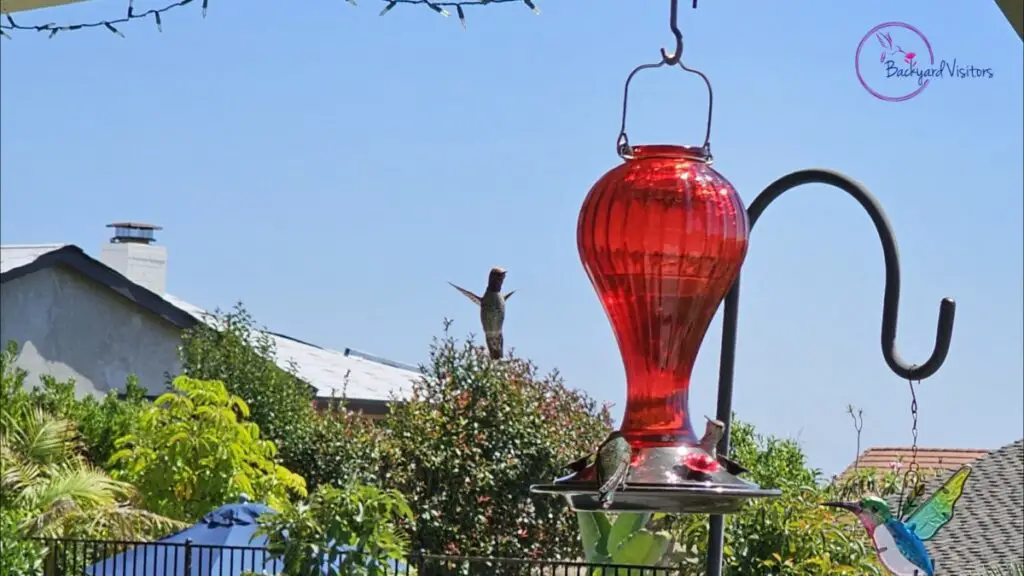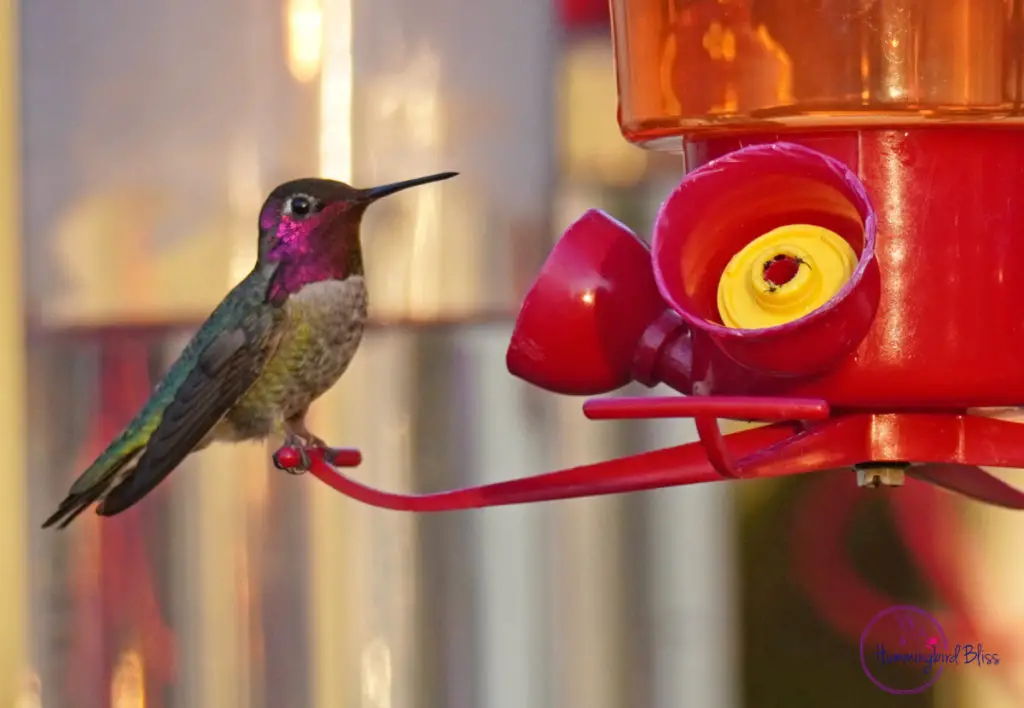This post contains affiliate links.
I recently purchased a red glass hummingbird feeder and was amazed at my hummingbirds’ attraction to it. They seemed to prefer it to the other clear feeders with red components. I moved it around and positioned it in other feeder locations in my yard, however my hummingbirds seemed to still prefer it over the other feeders.
So I did some research to see if I could understand why this was happening.
This article explains why hummingbirds are attracted to red hummingbird feeders.
Do Hummingbirds Like Red Feeders?
Hummingbirds’ attraction to red feeders comes from their specialized vision, characterized by a high concentration of cones in their retina that contain distinct pigments and oil droplets, which enhance their sensitivity to colors within the red spectrum.
Hummingbirds are attracted to and often exhibit a preference for red feeders and flowers. This affinity for the color red stems from the unique anatomy of a hummingbird’s eyes.
Hummingbirds are naturally drawn to red flowers because they offer the finest nectar, which is what they seek out regardless of bloom color.
The hummingbird’s ability to smell the concentration of sugar in the flower is equally or even more important than the color itself.
See my article: Can Hummingbirds Detect Scents: A Complete Guide
Red is a popular choice for hummingbird feeders, however, it is not the only color that is attractive to them. Some feeders also incorporate other bright and vibrant colors, such as orange, pink, blue, purple, or any iridescent feather color.
See my article: Hummingbird Feathers: A Closer Look at Nature’s Design
My recent addition of ared glass hummingbird feeder has been a favorite in my backyard.

It is very attractive and easy to clean!
Most hummingbird feeders of any color incorporate the color red somewhere on the feeder.
Many hummingbird feeders are designed with red parts or are entirely red to entice these birds to visit and feed. The red display and visual design of the feeder draw their attention by signaling to hummingbirds a potential food source location.
Should I Use Clear or Red Hummingbird Feeders?
Red hummingbird feeders will attract more hummingbirds than clear feeders, but hummingbirds will also be attracted to clear feeders if the feeder has some red components such as flowers, perches, and tops.
Hummingbirds are attracted to the color red because it symbolizes a richer and higher-quality nectar source, and the hummingbird’s eyes have special anatomical structures that are adapted to seeing the red color spectrum.
Hummingbird feeders come in all shapes, sizes, colors, and functionality.
Red Hummingbird Feeders
Red hummingbird feeders made of glass are better to use than the red plastic feeders.
The problem with most glass hummingbird feeders is the very narrow entry to the nectar holding tank, which makes it difficult to clean the feeder.
The nectar tank shape can also add to the cleaning difficulty; most are not cylindrical like a standard plastic feeder.

tank opening and is difficult to clean.
The red glass feeder that I use is user-friendly for cleaning and is much more appealing to the eye than my plastic feeder. Even though it is more expensive than my plastic feeders, it is still quite affordable, and my hummingbirds love it!
Clear Hummingbird Feeders
When purchasing a clear hummingbird feeder, it is beneficial to choose one with red components, imitating nature. Red flowers signal to the hummingbird a high content of nectar.
I incorporate clear hummingbird feeders in my backyard because they are adequate and inexpensive.
Clear feeders offer transparency for monitoring and refilling the nectar in the feeder.
The clear part of the feeder allows one to monitor the clarity of the nectar and signals when a new batch of homemade nectar is necessary.

of sugar water remaining in the clear feeder.
Red feeder parts on a clear feeder, such as the base or feeding ports, help to captivate the attention of hummingbirds more effectively because hummingbirds associate the red components with red flowers, which contain more nectar.
Glass vs. Plastic Feeders
Glass and plastic feeders are the two main materials used for the multitude of feeders and designs that are available, including large tank or small saucer-style hummingbird feeders.
Saucer-style feeders are usually plastic and are the style of feeder that can have a heater attached to keep nectar from freezing in the winter.
See my article: How to Help Hummingbirds in Cold Weather.
The glass option is more durable over time as it prevents fading and warping of the feeder and provides less UV exposure to the homemade hummingbird nectar.
The plastic feeders are less expensive and are more susceptible to wind elements when they are empty.
Functionality
Pick a hummingbird feeder that is easy to disassemble and clean.
Hummingbird feeders can grow mold pretty quickly in warm weather, and they should be cleaned at least every other day in the summer.
See my article: What is the Black Stuff on My Hummingbird Feeder?

Select a hummingbird feeder with a tank size that the hummingbirds will empty in two days. In the summer, feeders need to be cleaned every other day.
Decide if the feeder will have an attached perch for the hummingbird to sit on while drinking.
Hummingbirds are attracted to tubular-shaped flowers as they are one of the pollinators that can reach the nectar.
I’m wondering if the shape of my new red glass hummingbird feeder, which resembles a long tubular shape, has some effect on their extraordinary attraction to it.

The main parts of a hummingbird feeder are:
- Tank
- Base
- Flower Ports
- Perch
- Mounting Bracket
- Ant Moat
- Bee Guard
- Baffle
Depending on your preference, any and all of these components can be swapped out for colored or transparent counterparts.
Your imagination is the only restriction on the possible combinations.
Practice, play, and integrate these options into your backyard.
All of these extra advantages are not necessary but are nice perks for attracting hummingbirds.
Experiment with the shape, color, and special features of clear or red feeders and see what works best with the hummingbird species in your area and specific location.
When purchasing a hummingbird feeder, it is important to keep in mind that hummingbirds have cones in their eyes that are sensitive to the color red.
Do not use red dye to give the hummingbird feeder the appearance of being red.
Red dye is potentially dangerous for hummingbirds to consume.
Always provide hummingbirds with clear homemade sugar water nectar.
See my article: Forget Commercial Nectar, Try Making Homemade Nectar.
What Color Feeders Attract Hummingbirds?
A red hummingbird feeder is the most attractive color to hummingbirds because of special anatomical structures in their eyes designed to specifically see red. Feeder colors that also attract hummingbirds are the colors seen in hummingbirds’ iridescent feathers, such as orange, pink, blue, and purple.
Red, orange, pink, and purple colors also mimic the flowers they feed on in the wild.
Clear hummingbird feeders usually have added red parts to the clear tank to attract the hummingbirds’ attention. Most have red tops, red bases, red perches, and red flowers with some yellow to help the hummingbird focus on the feeding ports.
Never use red dye in the clear homemade nectar to attract hummingbirds, as it is potentially dangerous for hummingbirds to consume.
See my article: The One Thing You Need to Eliminate From a Hummingbird’s Diet.
Red is a highly visible color to hummingbirds, and they associate it with nectar-rich flowers from which they forage.
Hummingbirds have special sensors in their eyes that make them sensitive to the color red, so it is highly recommended that the feeder have some red components.
Some multicolored feeders use a variety of colors to attract hummingbirds.
Besides red, hummingbirds are particularly attracted to colors such as orange, pink, blue, and purple.
Although not entirely red, the combination of red, pink, orange, blue, and purple hues is used in some multicolored hummingbird feeders to attract them.
These multicolored hummingbird feeders add a lot of elegance to a porch or garden area.
Should My Hummingbird Nectar Be Red?
Avoid adding red dye to homemade hummingbird nectar, as it is unnecessary and may pose potential health risks. Select red feeders or feeders with red components and make clear homemade nectar for a safe and effective way to attract hummingbirds.
Using artificial red dye is not recommended when making homemade hummingbird nectar to feed hummingbirds. They are naturally drawn to the brightly colored parts of a hummingbird feeder, especially those that feature a red base, red flowers, or other red components.
Hummingbirds are attracted to red tubular flowers which reward them with sweet rich delicious nectar. The nectar itself is transparent, not red.
In the 1970s, there was a scare about a red food dye called Amaranth, which led to worries about its link to cancer in lab rats. As a result, the FDA banned Amaranth from food products. It was replaced with Red Dye No. 40, known as Allura Red, which is presently used today. Even though it is FDA-approved for humans, there are still concerns about its adverse effects related to children’s behavior.
While there is no concrete evidence linking red dye to harming hummingbirds, experienced bird rehabilitators have documented and noted health issues. The best practice is to avoid using synthetic red dyes and artificial food coloring when making homemade hummingbird nectar.
Products with added synthetic coloring, notably Red Dye No. 40, are non-essential, provide no health benefits, may have negative and harmful consequences for hummingbirds, and are a waste of money. Artificial red dye introduces unnecessary chemicals to a hummingbird’s diet.
See my article: Forget Commercial Hummingbird Food, Try Making Homemade Nectar.
The best way to attract hummingbirds to your garden is to use a hummingbird feeder with red components while filling it with clear homemade hummingbird nectar without synthetic red coloring.
Stick to a simple 1 part sugar to 4 parts water (1:4) homemade hummingbird nectar recipe.
Remember to clean your hummingbird feeder frequently and change the nectar every few days, especially in hot weather, to keep it fresh. This is a safe and effective way to give hummingbirds healthy, accessible nutrition without giving them harmful, manufactured sources of food.
Check out my other posts on Hummingbird Questions
Happy Hummingbird Watching
Backyard Visitors participates in affiliate programs which compensate us for referring traffic.


